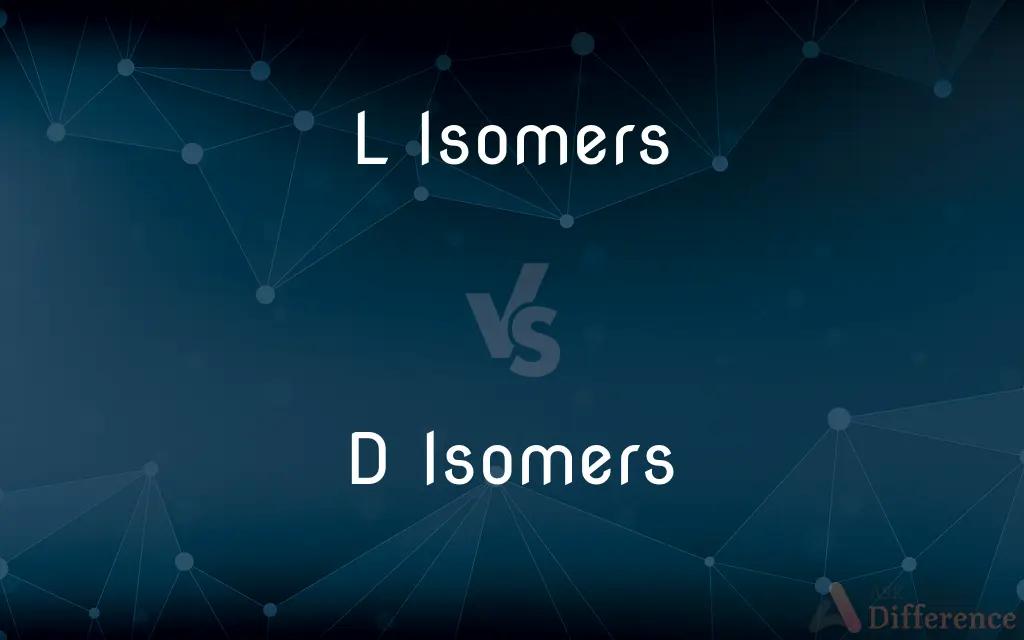L Isomers vs. D Isomers — What's the Difference?
By Tayyaba Rehman — Published on December 23, 2023
L Isomers and D Isomers are mirror-image forms of chiral molecules. L Isomers rotate plane-polarized light counterclockwise; D Isomers rotate it clockwise. Both have identical physical properties but often differ biologically.

Difference Between L Isomers and D Isomers
Table of Contents
ADVERTISEMENT
Key Differences
L Isomers, often referred to as "levorotatory" isomers, are one of the two possible spatial arrangements of a chiral molecule. When plane-polarized light passes through a solution of L Isomers, it is rotated in a counterclockwise direction. On the other hand, D Isomers, known as "dextrorotatory" isomers, represent the other possible configuration of the chiral molecule.
D Isomers cause plane-polarized light to rotate in a clockwise direction when it traverses through a solution of these molecules. It's essential to understand that L Isomers and D Isomers are non-superimposable mirror images of each other, much like left and right hands. Both these forms exist because of the asymmetry in certain molecules, with a central atom bonded to four different groups.
While L Isomers and D Isomers might possess identical physical properties such as melting points or boiling points, they can exhibit vastly different biological activities. For instance, one form might be therapeutic, while its mirror image could be harmful. Such distinctions are particularly crucial in the realm of drug design and pharmacology.
To further emphasize, L Isomers and D Isomers, though looking alike and having the same chemical composition, can behave distinctly when interacting with other chiral entities, especially biological ones. Thus, distinguishing between these two isomers becomes paramount in various scientific and medical fields.
Comparison Chart
Rotation of Polarized Light
Rotates plane-polarized light counterclockwise.
Rotates plane-polarized light clockwise.
ADVERTISEMENT
Also Known As
Levorotatory isomers.
Dextrorotatory isomers.
Mirror Image of
D Isomers.
L Isomers.
Interaction with Biological Systems
Might have different biological activity compared to D Isomers.
Might have different biological activity compared to L Isomers.
Example
L-glucose.
D-glucose.
Compare with Definitions
L Isomers
Often found in biological systems.
Many naturally occurring amino acids are L Isomers.
D Isomers
These isomers cause a clockwise rotation of plane-polarized light.
Light passing through a D-glucose solution will rotate to the right.
L Isomers
L Isomers are non-superimposable mirror images of D Isomers.
L-ascorbic acid has the same composition as its D form but a different spatial arrangement.
D Isomers
D Isomers represent one of the two chiral forms of a molecule.
D-fructose is a sugar that is an example of D Isomers.
L Isomers
L Isomers are one of two chiral configurations of a molecule.
L-alanine is an amino acid that is an example of L Isomers.
D Isomers
D Isomers are mirror images of L Isomers but are non-superimposable.
D-alanine and L-alanine are mirror images but can't be superimposed.
L Isomers
These isomers rotate plane-polarized light counterclockwise.
When a light passed through an L-glucose solution, it turned counterclockwise.
D Isomers
Commonly observed in nature.
D-glucose is the naturally occurring form of glucose.
L Isomers
These can have distinct biological effects compared to their D counterparts.
L-methamphetamine has different effects than its D counterpart.
D Isomers
Their biological activities can differ significantly from the L forms.
D-thalidomide has different biological properties than L-thalidomide.
Common Curiosities
Do L Isomers have the same physical properties as D Isomers?
They generally have identical physical properties, but their biological activities can differ.
What are L Isomers?
L Isomers are one of two chiral configurations of molecules that rotate plane-polarized light counterclockwise.
Which isomer, L or D, is more common in nature?
It varies, but many naturally occurring amino acids are L Isomers, while D-glucose is the naturally occurring form of glucose.
How do D Isomers affect plane-polarized light?
D Isomers cause plane-polarized light to rotate in a clockwise direction.
What's an example of a D Isomer in nature?
D-glucose is a naturally occurring form of glucose.
Why are L and D distinctions important in medicine?
Because one form might be therapeutic while the other could be harmful.
Are L Isomers and D Isomers mirror images of each other?
Yes, L Isomers and D Isomers are non-superimposable mirror images.
Can I convert L Isomers to D Isomers?
In a lab setting, it's possible to convert between these forms using specific chemical reactions.
Do all molecules have L and D forms?
No, only chiral molecules, those with asymmetry, have L and D forms.
Are L Isomers always levorotatory?
Generally, yes, L Isomers rotate plane-polarized light counterclockwise.
How are L Isomers and D Isomers identified in a lab?
They are often identified using a polarimeter to observe the direction of light rotation.
Why can't L Isomers superimpose on D Isomers?
They have different spatial arrangements, much like left and right hands.
What is the significance of the "D" in D Isomers?
The "D" stands for dextrorotatory, meaning it rotates plane-polarized light to the right.
What happens if I consume a drug with the wrong isomer form?
It can lead to reduced efficacy or adverse effects, which is why isomer purity is vital in pharmaceuticals.
Are L and D classifications the same as R and S nomenclatures?
No, while both denote chirality, R and S are based on atomic arrangements, and L and D are based on optical activity.
Share Your Discovery

Previous Comparison
Mountain Lion vs. Bobcat
Next Comparison
In Situ Conservation vs. Ex Situ ConservationAuthor Spotlight
Written by
Tayyaba RehmanTayyaba Rehman is a distinguished writer, currently serving as a primary contributor to askdifference.com. As a researcher in semantics and etymology, Tayyaba's passion for the complexity of languages and their distinctions has found a perfect home on the platform. Tayyaba delves into the intricacies of language, distinguishing between commonly confused words and phrases, thereby providing clarity for readers worldwide.
















































